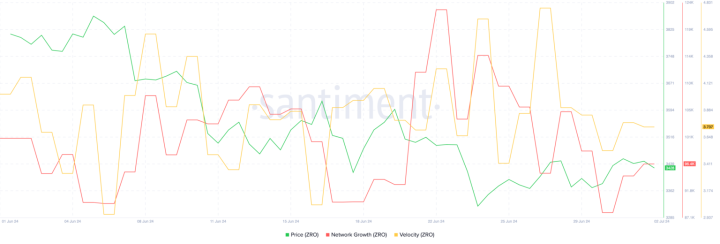The LayerZero (ZRO) token has been making headlines lately, experiencing a dramatic surge in price. Over the past week, ZRO has risen by an impressive 52%, catching the attention of investors and crypto enthusiasts alike. But amidst this excitement, concerns about the security of the LayerZero protocol have surfaced, casting a shadow on its future. Is ZRO poised for further gains, or will these security challenges hinder its progress?
ZRO to the Moon? Analyzing the Recent Price Surge
- The Rise: The ZRO token has witnessed a significant surge in price over the past week, with the token’s price surging by 52%.
Despite the price increase, data suggests a potential slowdown in user adoption. Bitcoinworld’s analysis of Santiment’s data indicated that its Network Growth had declined, suggesting new users are losing interest. Coupled with that, the Velocity had fallen, which was indicative of the fact that the frequency at which ZRO was trading at, had slowed down.

Security Concerns: A Cloud Over LayerZero?
Adding to the uncertainty are conversations surrounding potential security vulnerabilities within the LayerZero protocol. These concerns, if validated, could significantly impact the ZRO token’s long-term prospects.
0x52’s inspection of the UXDProtocol under the SherlockDefi program uncovered potential issues with LayerZero. The user claimed that the Layer Zero endpoint contract, responsible for message flow between protocols, lacked restrictions on message size and destination addresses.
This alleged vulnerability could allow a malicious actor to send a message with an excessively large destination address, intentionally causing errors within the contract. Such errors could disrupt communication between different blockchain networks, potentially leading to financial losses for protocols relying on LayerZero.
According to 0x52, this vulnerability could affect many protocols using LayerZero, especially those involving both EVM (Ethereum [ETH] Virtual Machine) chains and non-EVM chains like Solana [SOL], which use different address sizes.
LayerZero’s Rebuttal: Addressing the Concerns
LayerZero Labs didn’t remain silent in the face of these accusations. Bryan Pellegrino, the co-founder and CEO, addressed 0x52’s concerns directly.
Pellegrino argued that the ability for applications to configure payload limits was a deliberate design choice made with a specific purpose in mind. Imposing a fixed limit on message size could introduce the possibility of censorship, which directly contradicts LayerZero’s core goal of fostering a censorship-resistant system.
Pellegrino further clarified that the code referenced by 0x52 belonged to 2022 and was related to application configuration, not the core protocol itself. This distinction is crucial, as it implies the vulnerability doesn’t lie within the fundamental workings of LayerZero.
Pellegrino went on to explain that the payload size limit functions as part of an application’s security settings, granting individual applications the power to adjust it according to their specific needs.
After hearing about this response, 0x52 deleted all their previous tweets and agreed with Pellegrino.
The Weighted Sentiment around ZRO was negative at press time, however, there was a significant improvement in the overall outlook around the protocol, compared to the last few weeks.
If sentiment continues to improve, it could be reflected in ZRO’s price movement as well. At press time, ZR was trading at $3.89.
Disclaimer: The information provided is not trading advice, Bitcoinworld.co.in holds no liability for any investments made based on the information provided on this page. We strongly recommend independent research and/or consultation with a qualified professional before making any investment decisions.


